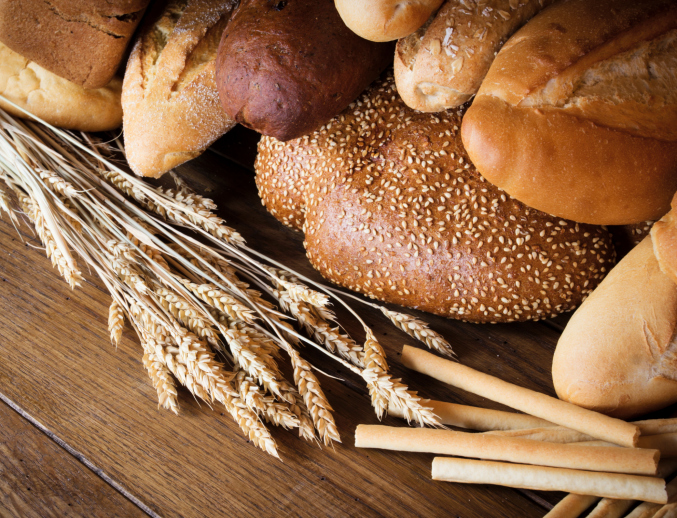Did you know that whole grains are an important part of healthy eating?
Whole grains contain many vitamins and nutrients that refined grains lack. Foods made with whole grains contain all three parts of the grain kernel—the bran, germ and endosperm. Refined grains are processed to remove the bran and the germ to create a finer texture and lengthen shelf life.
When grains like wheat are processed and refined, it results in the loss of valuable nutrients. In contrast, you can find high amounts of Vitamin E, B vitamins, zinc, selenium, copper, iron, manganese and magnesium in whole grains. Whole grains also contain more fiber than their refined counterparts.
How can whole grains benefit my health?
Eating whole grains rather than refined grains may reduce your risk of health issues such as elevated cholesterol, high blood pressure, stroke, type 2 diabetes and certain cancers. The extra fiber in whole grains helps promote a healthy digestive tract. If you are interested in losing weight, whole grains are a good option as they help you feel full longer and are lower in calories than refined products.
For those with Celiac disease or gluten intolerance, there are plenty of naturally gluten-free whole grains to choose from, such as amaranth, buckwheat, corn, quinoa, wild rice and brown rice. In this case, it’s often best to choose certified gluten-free grain products that have not come into contact with gluten-containing grains like wheat.
What are the recommendations for whole grains?
At least half of the grains you eat should be from whole grain sources—that’s about 3 servings a day. Examples of servings of whole grains include:
- One slice of whole wheat bread
- ½ of a whole wheat English muffin
- ½ cup of oatmeal
- ½ cup of cooked brown rice
- ½ cup of cooked whole wheat pasta
How can I tell if a product is really a whole grain?
Check the ingredient list. Look for the word “whole” prior to the grain–for example, whole wheat.
- Be wary of products that sell themselves as “100% wheat,” “multi-grain,” “contains whole grain,” “bran,” and “made with whole grains.” Often, these products may not actually be whole grain foods.
- Notice the color. Whole grains generally have a darker appearance, but note that there are some food products which may also be naturally darker such as rye (which may or may not be whole grain). Always check the label to know for sure. (In the case of rye bread, to ensure it is whole grain, look for the word “whole” to appear before “rye” in the ingredient list.)
- Familiarize yourself with products that are always whole grains, such oatmeal, brown rice, wild rice, quinoa, popcorn, amaranth, couscous, buckwheat, bulgur and millet.
- Look for the whole grain stamp. Products with the stamp must have a minimum of 8 grams of whole grains per serving.
Tips for Getting More Whole Grains
- Start the day with whole grains. Cereal-eaters, opt for a whole grain variety. Or try whole grain toast, English muffins or bagels. For an extra nutritional punch, make oatmeal and add fruit or nuts.
- Use whole grain breads for sandwiches.
- For side dishes, substitute a whole grain like brown rice for white potatoes or white rice.
- Try whole wheat pasta. If the whole grain products are too chewy for you, look for those made with half whole wheat or mix half a package of regular pasta with half a package of whole wheat pasta.
- Swap your refined grain products for whole grain products. For example, use whole wheat tortillas when you make wraps and whole wheat English muffins and bagels for your breakfast.
- Choose foods that are naturally whole grains, like oatmeal.
- Bake your cookies, cakes and breads with whole wheat or whole grain flour. If this strategy seems too challenging, substitute only a portion of the flour.
Looking for healthy whole grain recipes or additional nutrition information? If you are a Health Advocate member with access to our Wellness Coaching program, connect with a Wellness Coach for further ideas to eat healthy!




[…] one serving of whole grains such as brown rice, quinoa, whole grain bread, oatmeal, etc. three days each […]
[…] on healthy carbohydrates for energy. Opt for fruits, vegetables and whole grainsas your main sources of […]
[…] Many people associate “low-carb” with weight loss. However, this is a common misconception. Weight gain is not limited to one food group, but a surplus of calories in all food groups. Your body needs carbohydrates in order to function properly, especially if you are an active person. At the same time, carbohydrates provide many important nutrients like fiber, iron and B vitamins. Choosing the right kind of carbs and limiting unhealthy carbs may help you lose weight. You can do this by switching from refined grain products to whole grains. […]
[…] on healthy carbohydrates for energy. Opt for fruits, vegetables and whole grains as your main sources of […]